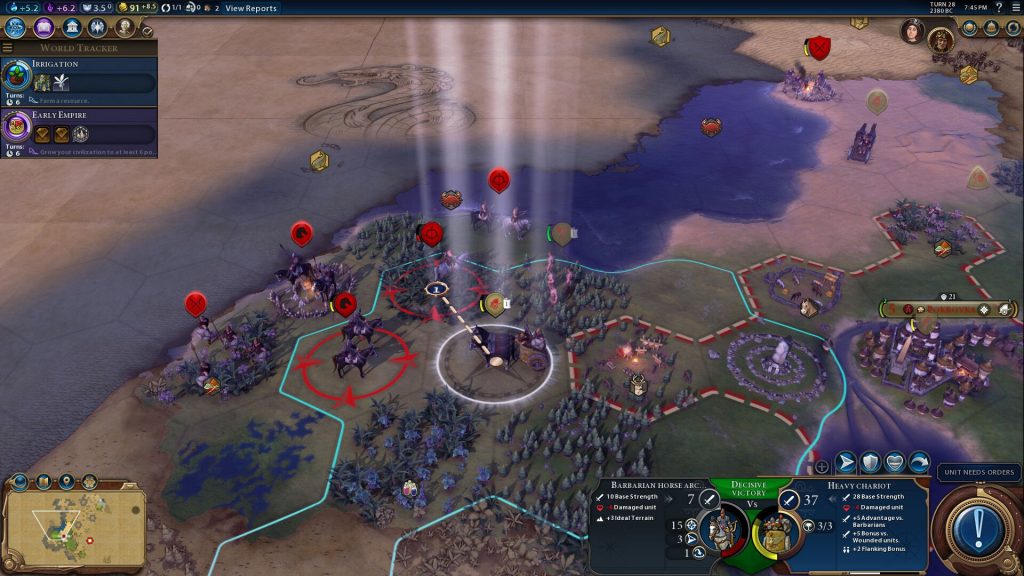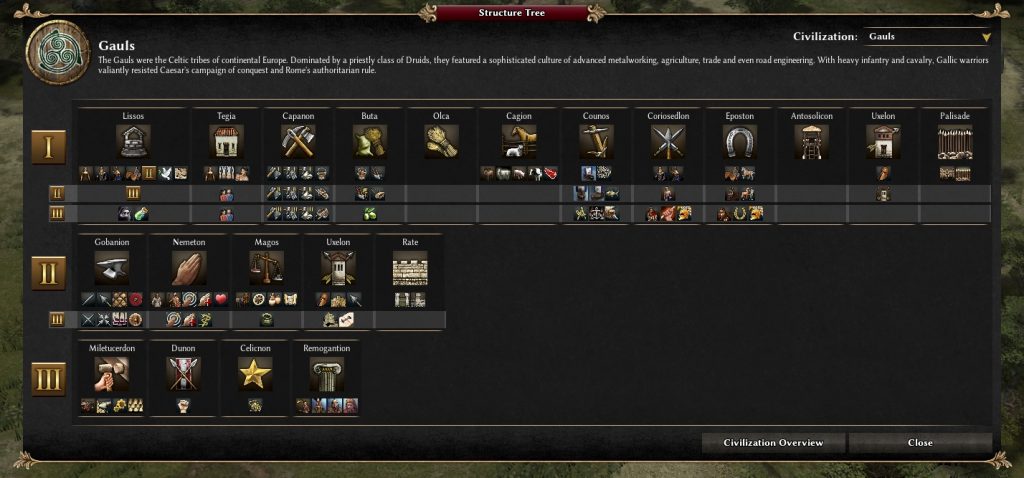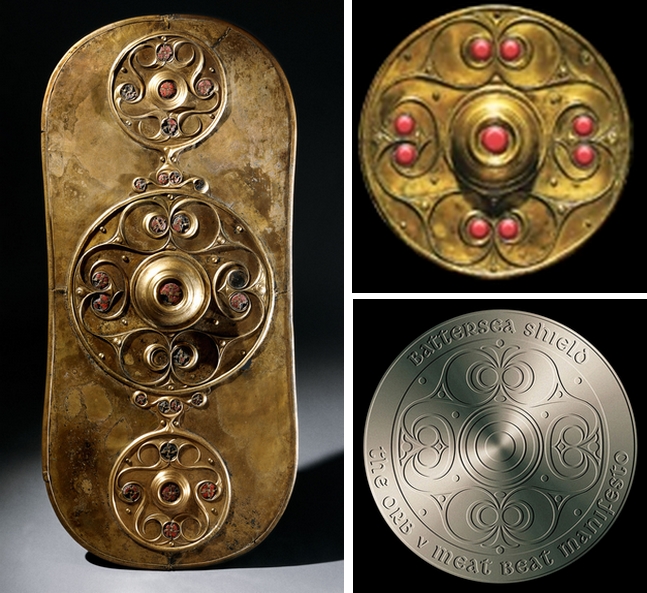We all know and love our Barbarians and simply can’t get enough of them. Swaying their axes into history and chopping down civilizations wherever they set foot. Well, not in 0 A.D.!
Ah, the Barbarian, every historical games’ favorite ‘cannon fodder’. Picture a Barbarian for me, if you please. How do they look? What associations come to mind? Do you see a savage, primitive in their behaviour, uncivilized, a big and strong disruptive force of nature? Do they speak a language you know and bring words of noble wisdom or are they just screaming aloud while brandishing an axe? These uncivilized ‘others’ are an ill fit for a cultural history centered around the victory of civilization. No wonder we are supposed to slay hordes of them, we are protecting civilization as we know it! Right?
Wrong! While victors write the past to their liking, that does not mean that historic ‘barbarians’, such as how the Gallic tribes were described by Julius Caesar, are actually void of any culture or common humanity. Barbarians are not the chaotic evil force Caesar makes them out to be. Case in point? The 0 A.D. game! In this fourth installation of our series on this game, we will show how it provides a more balanced view of ‘Barbarians’ in antiquity.

The Barbarian in Context
Barbarians in other video games are often depicted in many other roles, but still are a good general enemy for the player to fight against. In the early Sid Meier’s Civilization series, where the player has to build an empire to stand the test of time, barbarians are annoying pests that are dwelling around the cities of the players. They are, for example, trying to destroy granaries, bridges, and other improvements. If the player is unlucky, they can also capture cities. Until the fifth main installment of the series, barbarians were uncivilized, but also underdeveloped/undercoded. While the player progresses through time, barbarians are stuck in their own ‘chronosphere’, one or many steps behind. Fulfilling the same role mechanically as a force of nature or a wild animal: a nuisance to overcome through our culture’s ingenuity.
The real-time medieval strategy game Stronghold 2 (Firefly 2005) also has barbarian-like units. Next to civilized/normal units such as the archer, swordsmen, pikemen, and knights, which are recruited through the barracks, players can also construct the mercenary camp to recruit ‘exotic’ units. This camp holds the Pictish Boat Warriors, axe throwers, and Viking berserkers among others. Especially the berserker resembles how barbarians in general look: uncivilized, can not speak properly as we used to, know how to fight with blunt weapons, and wear almost no clothes. The mercenaries do not look different and have different weapons from the ‘normal units’, they can only be recruited by spending money. To an extent, it can also say that ‘the other’ is prone to financial incentives.

0 A.D. Says No to Barbarians
Alright, it is not completely true that there are no ‘Barbarians’ as they would have been historically constructed in the game 0 A.D., but not to worry, it is not a clickbait title. The ’Barbaric’ civilizations that can be played in 0 A.D. are titled ‘Gauls’ and ‘Britons’, in other games known under the title ‘Barbarian’. For example, Imperator Rome still had ‘Barbarian’ military tactics for both these peoples before the update ‘Marius’. Now let’s take a look at how the Gauls are introduced.
‘The Gauls were the Celtic tribes of continental Europe. Dominated by a priestly class of Druids, they feature a sophisticated culture of advanced metalworking, agriculture, trade, and even road engineering. With heavy infantry and cavalry, Gallic warriors valiantly resisted Ceasar’s campaign of conquest and Rome’s authoritarian rule.’
The way the Gauls are presented in this game marks a fundamental change from everything ‘the Barbarian’ stands for in our minds. This piece of text does not just convey the information that the Gauls had advanced skills in metalworking, for example, but it specifically points out that they have sophisticated culture. This points to all of the other examples in modern media that portray the Gauls as culture-barren peoples and makes a statement that those are wrong. Moreover, their military interactions are not framed as hopeless, but rather valiant. This paints a much more positive picture of the Gauls than we are used to.

The makers of 0 A.D. don’t just stop there. They are actively trying to bring language back to the Gauls. A lot of games would use Roman words to describe Gallic peoples (since Romans wrote about them and there are very, very few sources left of these peoples from their own viewpoint, safe from archaeological remains. For example, a Gallic woman is called a ‘Bena’, which is actually from the Proto-Celtic *benā, from Proto-Indo-European *gʷḗn, pronounced benā, meaning wife or woman. Or what is for the Romans a ‘forum’, for the Gauls this becomes a ‘lissos’, coming from a Proto-Celtic origin and meaning something as court or palace. These are just some examples, but they showcase something of vital importance. The effort to show that these barbarians were not without language and that they deserve, wherever possible, to be expressed in terms, not by their ‘victors’ aka Romans.
Another thing that I want to rave about is the Britons. They are not just copy-pasted Gauls with a name change (looking at you, older version of Imperator: Rome), but they receive unique features as well. Sure, their clothes are the same, but immediately the player will see a whole different building, a round hut. This is called a Tigernotreba, which loosely translates to ‘the lord’s/master’s settlement’, so even an effort is made to give Britons their different language from Gauls.

If you’re interested, there is this whole Celtic thread on their forum about ancient proto-Celtic languages, prefixes, word roots, conjugations, and a whole lot more! This really goes to show that people playing this game are actually interested in this language used and try to contribute. Reputable sources are cited and clearly, this person has knowledge of how languages work and even makes suggestions on how to improve the used words.
The Britons are introduced to us this way: ‘The Britons were the Celtic tribes of the British Isles. Using chariots, longswordsmen and powerful melee soldiers, they staged fearsome revolts against Rome to protect customs and interests. Also, they built thousands of unique structures such as hill forts, crannogs, and brochs.’
They are basically introduced in a similar way. They do have a culture since they constructed thousands of unique structures. Secondly, they are not merely a footnote in Rome’s history or some annoying rebels. No, they staged fearsome revolts and the reason for this is to protect their customs and interests. They do not just try to bash the Romans for fun, or because they are aggressive, they simply try to protect their own culture.
In 0 A.D.portrayals of barbaric ‘barbaric peoples’ go above and beyond to recreate a balanced view of cultures that thrived before the Romans came over and wrote their version of their history, the one that we learn in schools. It is telling that 0 A.D. tries and largely succeeds at giving a nuanced version of the exact people usually used as ‘ enemy cannon fodder in so many other games. This is yet another reason why 0 A.D. is truly a breath of fresh air in the genre of video games set in Antiquity.

Tirreg Verburg has his real Dutch name in the game. He is an independent scholar in the fields of History in- and of video games. With a research master Renaissance Studies gym badge in the pocket, he tries to collect other achievements within the ludic world of game studies and history. Next to being a PC-gamer, he quite frequently returns to the era of the Nintendo GameCube. He also enjoys video game music and has had frequent run-ins with the Oblivion guards.

